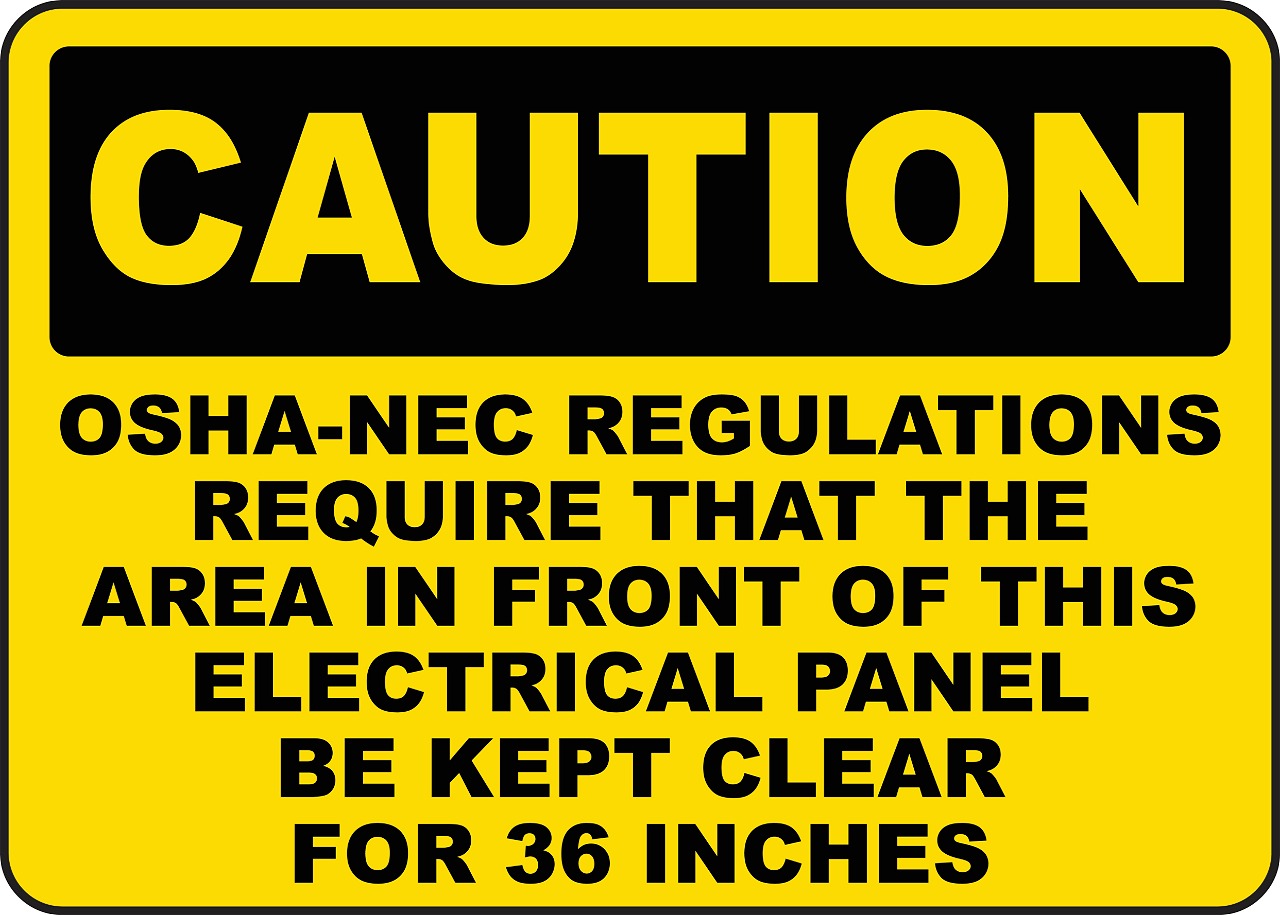Electrical panels are the heart of your property’s electrical system, distributing power to every outlet, appliance, and fixture. But did you know that improper electrical panel clearances can lead to serious safety hazards, code violations, and costly repairs?
At Pelican Coast Electric, we’ve seen how inadequate clearances can put both residential and commercial properties at risk. That’s why we prioritize educating homeowners and business owners on NEC electrical panel clearance requirements. By following the proper standards, you’ll ensure easy access during emergencies, reduce risks, and stay compliant with local regulations.
In this guide, we’ll break down everything you need to know about electrical panel clearance requirements, including code specifics, common violations, and best practices to keep your property safe.
Why Electrical Panel Clearance Matters
Ensuring the proper electrical code panel clearance is not just about compliance—it’s about protecting lives and property. Without adequate clearance, electrical workers and first responders may not have enough room to safely operate your panel, especially in emergencies.
Failing to meet clearance standards could lead to:
- Increased risk of electrical fires and shock hazards.
- Difficulty accessing and shutting down power during emergencies.
- Expensive fines or penalties from code violations.
- Liability risks if accidents occur on your property.
Whether you own a home or business, maintaining clear working space around your electrical panel is essential. Pelican Coast Electric can help you inspect and upgrade your system to meet NEC electrical panel clearance requirements and local regulations.
What Are the NEC Electrical Panel Clearance Requirements?
The National Electrical Code (NEC) sets detailed clearance guidelines to protect anyone working on or near an electrical panel. These standards ensure there is adequate space to safely inspect, maintain, and repair electrical equipment.
Here’s a breakdown of the key NEC clearance requirements:
1. Front Clearance (Working Space)
According to NEC electrical panel clearance requirements, there must be a minimum of 36 inches of clear working space in front of the panel. This allows electricians to move freely and reduces the risk of accidental contact with live components.
Front clearance must remain unobstructed at all times—no storage boxes, furniture, or equipment should block this space. In homes, this is one of the most commonly violated clearance rules.
2. Width Clearance
The working space around the panel must be at least 30 inches wide, or the width of the panel, whichever is greater. This ensures that technicians have enough room to access wiring and other components without crowding or obstruction.
For commercial properties, maintaining this width is especially crucial due to stricter OSHA electrical panel clearance requirements aimed at workplace safety.
3. Height Clearance (Vertical Clearance)
The NEC requires that there be at least 6.5 feet (78 inches) of clear vertical space above the panel. No shelving, ceiling obstructions, or overhead fixtures should restrict this height.
You may also hear this referred to as the electrical panel clearance 42 rule, referencing height guidelines commonly used in various electrical applications.
Residential Electrical Panel Clearance Requirements
In homes, clearance violations often occur when panels are installed in poorly chosen locations such as closets, laundry rooms, or bathrooms. Homeowners may inadvertently block access by placing furniture or storage items too close to the panel.
To meet residential electrical panel clearance requirements, ensure that:
- The panel is installed in a readily accessible area, such as a garage or utility room.
- There is always 36 inches of front clearance and 30 inches of width clearance.
- Family members understand the importance of keeping this area unobstructed.
Failing to comply with residential clearance codes can not only increase fire risks but also prevent emergency responders from shutting down power quickly in dangerous situations.

OSHA Electrical Panel Clearance Requirements for Businesses
In commercial settings, compliance with OSHA electrical panel clearance requirements is mandatory to protect workers and contractors. OSHA frequently inspects businesses for safety violations, and inadequate panel clearances can result in fines or shutdowns.
OSHA standards align with NEC requirements but emphasize additional workplace safety measures, such as:
- Clear markings and warning signs to indicate panel clearance zones.
- Employee training programs to prevent unintentional obstructions.
- Routine inspections to verify compliance with both OSHA and NEC guidelines.
If your business hasn’t recently had an electrical inspection, now is the time to act. Pelican Coast Electric can assess your property and ensure you meet all clearance and safety requirements.
Common Violations of Electrical Panel Clearance Codes
Property owners frequently violate clearance codes without realizing it. Here are some of the most common issues we encounter:
1. Obstructed Panels
Placing storage items or equipment too close to the panel is a frequent violation of the electrical panel clearance code. Many homeowners are unaware that stacking boxes or installing shelving near the panel puts them at risk of a code violation.
Tip: Designate the area around your panel as a “no storage zone” to avoid accidental obstructions.
2. Panels in Confined Spaces
Installing electrical panels in small closets, bathrooms, or crawlspaces violates electrical panel code clearance standards. These locations not only restrict access but also pose additional hazards in high-moisture areas like bathrooms.
Solution: Relocate the panel to an accessible, open area in compliance with NEC and OSHA regulations.
3. Failure to Maintain Clearance After Renovations
Home renovations can inadvertently reduce panel clearances. For example, adding new walls, shelves, or cabinetry near the panel may encroach on the required clearance for electrical panels.
Recommendation: Consult with a licensed electrician before making any structural changes near your panel.

Best Practices to Maintain Panel Clearance Compliance
To stay compliant and protect your property, follow these best practices:
1. Schedule Regular Inspections
Routine inspections by a certified electrician ensure that your panel complies with electrical code panel clearance requirements. Inspections also help detect early signs of wear, corrosion, or electrical malfunctions.
At Pelican Coast Electric, our inspection services provide peace of mind by keeping your system safe and up to code.
2. Use Warning Signs
Install clear signage near your panel to indicate the required working space. This is particularly important in workplaces where employees may accidentally obstruct the area.
3. Train Household Members or Employees
Education is key to preventing clearance violations. Make sure everyone in your home or business understands why the area around the electrical panel must remain clear at all times.

FAQ: Required Clearance For Electrical Panels
WHAT IS THE MINIMUM REQUIRED CLEARANCE FOR ELECTRICAL PANELS?
The NEC requires a minimum of 36 inches of front clearance, 30 inches of width clearance, and 6.5 feet of vertical clearance to ensure safe access to electrical panels.
CAN ELECTRICAL PANELS BE INSTALLED IN CLOSETS OR BATHROOMS?
No, installing panels in these locations violates electrical code panel clearance regulations. Panels must be placed in readily accessible, open areas.
HOW OFTEN SHOULD I HAVE MY ELECTRICAL PANEL INSPECTED?
Panels should be inspected every 3–5 years, or sooner if you experience electrical problems. Regular inspections ensure compliance with residential electrical panel clearance requirements and prevent hazardous conditions.
WHAT HAPPENS IF MY PANEL DOESN'T MEET CLEARANCE REQUIREMENTS?
Violating NEC electrical panel clearance requirements can result in fines, electrical hazards, and increased liability. Correcting clearance issues promptly is crucial for both safety and compliance.
HOW CAN PELICAN COAST ELECTRIC HELP WITH PANEL CLEARANCE?
Our licensed electricians provide expert inspections, upgrades, and installations to ensure your property meets all electrical panel clearance code standards. Contact us today for a consultation!
Conclusion
Don’t take risks with your electrical safety. By ensuring compliance with NEC electrical panel clearance requirements, you’ll protect your property, prevent accidents, and avoid costly violations.
Contact Pelican Coast Electric today to schedule your inspection and keep your electrical system safe and code-compliant!


